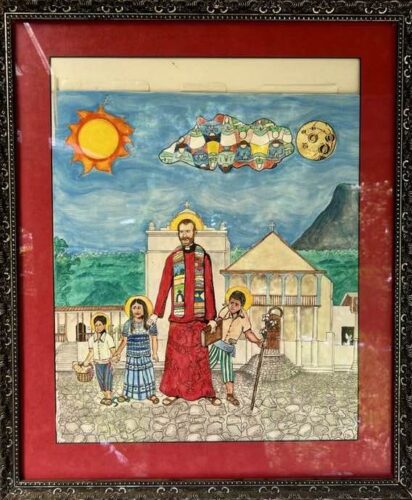
I write these words sitting on an old, uncomfortable, wooden pew in an almost 500-year-old cathedral nestled at the foot of a volcano and adjacent to Lake Atitlán.
When my conquistador ancestors entered the Mayan village named “house of the birds,” they tore down the temple and upon its ruins built a Catholic church, naming the church and town after James the disciple.
Built by the friars in 1547, in what today is called Guatemala, la iglesia católica de Santiago apóstol contains a beauty and simplicity which cannot be denied. And yet, this place where the worship of the “Prince of Peace” is lifted to the heavens, masks a violent evangelism.
This violence is the consequence of christianizing and civilizing the natives – a violence which has continued to this present time.
A painting of Father Stanley Rother, hanging inside La Iglesia Católica de Santiago Apóstol in Guatemala. (Photo: Miguel De La Torre)
Some 400 years after the construction of this church, Father Stanley Rother – an Oklahoma priest – requested to serve the archdiocese of Santiago Atitlán in 1968. There, he learned Spanish and the unwritten language of the Tz’utujil people, even translating the Christian Testament into their language.
He was less concerned with converting his parishioners to Jesus, motivated instead with being Jesus. Unimportant to him that the people continued to participate in the Indigenous rituals, he cared instead that the children were hungry, so he purchased land and started a farming co-op. He noticed that the sick were not being treated, so he began a small hospital.
I met Dolores, a woman now in her 70s, who is an elder and medicine woman within her Indigenous community. She shared her recollection of the priest, affectionately nicknamed Padre Apia. She recalled how as a nine-year-old she was malnourished and ill. She credits the good priest with saving her life.
Guatemala was in the midst of a 30-year civil war, a consequence of the CIA-led coup d’état of 1954 against the then democratically elected president Jacobo Arbenz. Some 200,000 – mainly Indigenous people – were killed and 45,000 disappeared during this time.
In the early 1980s, the persecution was intensified. Soon, some of Father Rother’s parishioners and catechists started to disappear; they were later found dead, showing signs of torture and severe beatings.
He was warned that his name was placed on the hit list of the right-wing death squad, led by officers trained at the U.S. military School of the Americas. In a letter to a friend about the violence faced, he wrote: “This is one of the reasons I have for staying in the face of physical harm. The shepherd cannot run at the first sign of danger.”
The tale of this one Christian ends July 28, 1981, when shortly after midnight the death squad found him in his bedroom. There, he was shot and killed.
Today, the bedroom has been transformed into a chapel. On the floor, to the right of the altar is a bullet hole from that night. I knelt there and prayed, honoring a simple man who chose to stand in solidarity with the oppressed when he could have easily run toward safety.
On December 1, 2016, Father Rother was beatified by Pope Francis.
Where the tale of this one Christian ends, the tale of another intersects.
José Efraín Ríos Montt, a military officer trained at the School of the Americas, gave his life to Jesus in 1978, leaving behind the Catholic Church of his childhood and becoming a devout evangelical associated with the Gospel Outreach Church.
Active in his church, he taught religious instruction, becoming friends with evangelical luminaries like Pat Robertson, Billy Graham and Jerry Falwell.
In March 1982, he participated in overthrowing the government, serving as its “president” until August 1983. Backed by the U.S. government and evangelical churches, he was seen as God’s chosen for the country.
On the one hand, he made moralizing Sunday sermons on national radio. On the other hand, he presided over the most bloody and brutal years of the civil war.
Under the slogan fusiles y frijoles (bullets and beans), he sought to pacify the rural Indigenous people through a scorched earth policy against the Mayan population, annihilating some 600 villages according to a 1999 UN report. During his 17-month term (until he was overthrown), his policy led to the murder of 1,771 Mayans.
On May 10, 2013, Montt was convicted of genocide and crimes against humanity and sentenced to 80 years in prison. He died of a heart attack in 2018, five years later, not in prison but in his own comfortable bed under house arrest due to a legal technicality which threw out his conviction.
These two men claimed to be disciples of Christ. One lived the gospel, the other proclaimed it. One stood in solidarity with the least of these, the other sought their destruction. One gets to stand on the right side of the throne, the other is told to go away, for even though they did great things in Jesus’ name, Christ never knew them.
As I watch the rise of Christian nationalism in the U.S., I cannot help but see the parallels.
I see those who, because of their faith, are working to make the lives of the least of these more humane, more bearable, more dignified. I also see those shouting about their faith from the rooftops, seeking to impose – as did Montt – one nation under God’s rules.
I see these Christian nationalists take matters into their own hands when they do not get their way – even to the point of storming the U.S. Capitol to bring about a non-democratic political result.
Montt in Guatemala and U.S. Christian nationalists are cut from the same cloth of violence and, therefore, both should be feared. Something about wolves in sheep clothing.
Professor of Social Ethics and Latinx Studies at Iliff School of Theology in Denver, Colorado, and a contributing correspondent at Good Faith Media.


